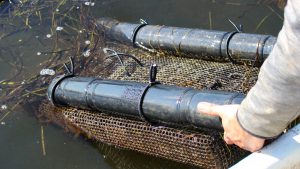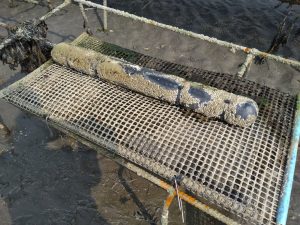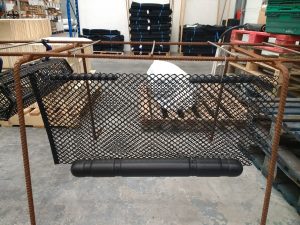We’re getting a lot of enquiries from growers who are interested in using a flotation system on their trestles to reduce labour and improve quality. Anyone who has visited the trade shows in France in the last few years will be aware that a number of companies there are working hard on developing a product that will work with the tide to cut out a lot of the hard graft required to turn the bags regularly by hand.
Triskell Seafood is working closely with a company who are in the final stages of rigorous testing for a new system which is due to be launched in September. More information about this launch will be available as soon as we are ready to bring it to market.


Until a full system is brought to market, or for those not yet ready to commit to the expense of a full-scale system, there are currently two types of floats available to attach to your oyster bags. The solid plastic float and the foam float.

Solid Float
The solid float can be attached onto your oyster bags using snap hooks or cable ties, the smooth surface makes the float very resistant to algal growth making them easy to clean and maintain. These floats are extremely robust and offer consistent buoyancy along their length.
Foam Float
The closed cell polyethylene foam floats function in much the same way. As the tides come in and out the float gives the bag consistent buoyancy. It is constantly moving with the tide thereby greatly reducing manual handling.
PE foam won’t allow water to migrate into the foam as each cell is enclosed. As a result the foam doesn’t act like a sponge and will not absorb water, allowing them to remain buoyant. A wax coating on the float protects the foam from birds pecking at and damaging the material.
The PE foam floats are extremely durable, even in the toughest maritime conditions. They are also lightweight meaning that they are very easy to work with and stack, while the closed cell manufacture means they don’t get compressed over time.
Adding floats to your set-up reduces labour and improves meat content and shape by allowing the oysters free movement within the bags. They’re a cost-effective way to make a big change for the better in how you farm oysters.
